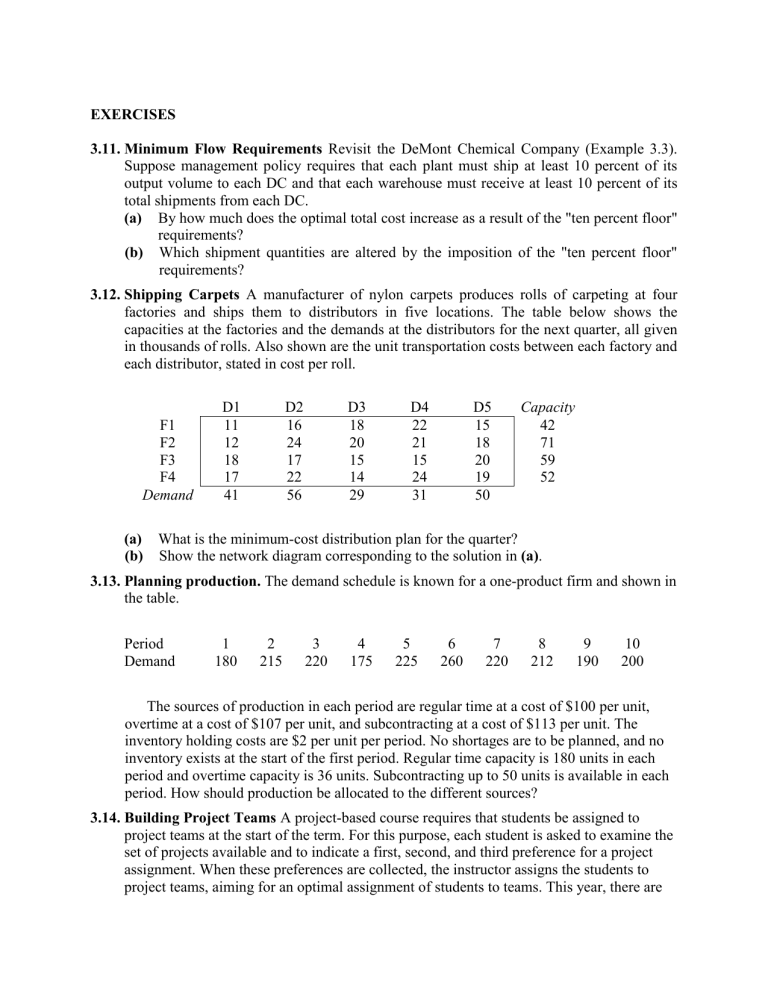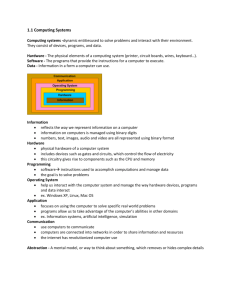exercises_3

EXERCISES
3.11. Minimum Flow Requirements Revisit the DeMont Chemical Company (Example 3.3).
Suppose management policy requires that each plant must ship at least 10 percent of its output volume to each DC and that each warehouse must receive at least 10 percent of its total shipments from each DC.
(a) By how much does the optimal total cost increase as a result of the "ten percent floor" requirements?
(b) Which shipment quantities are altered by the imposition of the "ten percent floor" requirements?
3.12.
Shipping Carpets A manufacturer of nylon carpets produces rolls of carpeting at four factories and ships them to distributors in five locations. The table below shows the capacities at the factories and the demands at the distributors for the next quarter, all given in thousands of rolls. Also shown are the unit transportation costs between each factory and each distributor, stated in cost per roll.
F1
F2
F3
F4
Demand 41
D1
11
12
18
17
D2
16
24
17
22
56
D3
18
20
15
14
29
D4
22
21
15
24
31
D5 Capacity
15
18
20
19
50
42
71
59
52
(a)
What is the minimum-cost distribution plan for the quarter?
(b) Show the network diagram corresponding to the solution in (a) .
3.13. Planning production. The demand schedule is known for a one-product firm and shown in the table.
Period
Demand
1 2 3 4 5 6 7 8 9 10
180 215 220 175 225 260 220 212 190 200
The sources of production in each period are regular time at a cost of $100 per unit, overtime at a cost of $107 per unit, and subcontracting at a cost of $113 per unit. The inventory holding costs are $2 per unit per period. No shortages are to be planned, and no inventory exists at the start of the first period. Regular time capacity is 180 units in each period and overtime capacity is 36 units. Subcontracting up to 50 units is available in each period. How should production be allocated to the different sources?
3.14. Building Project Teams A project-based course requires that students be assigned to project teams at the start of the term. For this purpose, each student is asked to examine the set of projects available and to indicate a first, second, and third preference for a project assignment. When these preferences are collected, the instructor assigns the students to project teams, aiming for an optimal assignment of students to teams. This year, there are
ten available projects and 16 students enrolled. There is a maximum team size, either 2 or
3, on each project, according to the nature of the work to be done. It is permissible for a student to work alone on a project (that is, in a team of size 1). The table below shows the student preferences and the maximum team sizes. A preference number of 3 represents the strongest preference.
Suppose we wish to maximize the sum of the preferences for the assignments made in the class. The ideal value would be 48, if every student were assigned to their preferred project, but that may not be possible. What is the largest possible value and what is the assignment that produces it?
P1
P2
P3
P4
S1 S2 S3 S4 S5 S6 S7 S8 S9 S10 S11 S12 S13 S14 S15 S16 limit
2
0
3
0
0
0
3
2
1
0
0
2
0
2
3
0
0
2
3
0
0
2
3
0
3
0
0
0
0
0
0
3
0
0
0
3
P5
P6
P7
P8
1
0
0
0
0
1
0
0
0
0
3
0
0
1
0
0
0
0
1
0
1
0
0
0
0
2
1
0
0
2
1
0
0
2
0
1
P9 0 0 0 0 0 0 0 0 0
P10 0 0 0 0 0 0 0 0 0
2
0
0
0
0
3
0
1
0
0
0
2
3
0
0
1
0
0
0
0
0
0
0
0
2
3
0
1
0
0
0
0
0
3
0
2
0
1
0
0
2
0
0
3
0
0
1
0
0
0
3
0
0
0
0
2
1
0
0
0
0
3
0
0
0
0
1
2
0
0
3
3
3
3
2
2
2
2
2
2
3.15. Transporting Grain The Sadeghian Company is in the business of buying and selling grain. An important aspect of the company’s business is arranging for the purchased grain to be shipped to customers. If the company can keep freight costs low, its profitability will be improved. Currently, the company has purchased three rail cars of grain at Peoria, seven rail cars at Iowa City, and six rail cars at Lawrence. Fourteen carloads of grain have been sold. The locations and the amount sold at each location are as follows.
Location
Augusta
Gainesville
Oxford
Columbia
Rail car loads
2
4
3
5
All shipments must be routed through either Louisville or Dayton. Shown below are the shipping costs per rail car from the origins to Louisville and Dayton and the costs per rail car to ship from Louisville and Dayton to the destinations.
Peoria
Iowa City
Lawrence
Louisville Dayton
1800
1400
1200
1500
1900
1600
Louisville
Dayton
Augusta Gainesville
4400
4200
3600
3500
Oxford
3300
3100
Columbia
3200
2700
(a) Determine a shipping schedule that will minimize the freight costs necessary to satisfy demand.
(b) Show the network diagram corresponding to the solution in (a) . That is, label each of the arcs in the solution and verify that the flows are consistent with the given information.
3.16. Designing a Distribution System The Krotzer Company manufactures and distributes meters used to measure electric power consumption. The company started with a small production plant in El Paso and gradually built a customer base throughout Texas. A distribution center was established in Ft Worth, and later, as the business expanded, a second distribution center was established in Santa Fe. The El Paso plant was expanded when the company began marketing its meters in Arizona, California, Nevada, and Utah.
With the growth of the West Coast business, the company opened a third distribution center in Las Vegas and just two years ago opened a second production plant in Sacramento.
Manufacturing costs differ between the company’s production plants. The cost of each meter produced at the El Paso plant is $10.50. The Sacramento plant uses newer and more efficient equipment, and as a result, its manufacturing costs come to only $10.00 per unit.
The quarterly production capacity is 30,000 meters at the older El Paso plant and
20,000 meters at the Sacramento plant. No shipments are allowed from the Sacramento plant to the Ft. Worth distribution center.
Due to the firm’s rapid growth, little attention has been paid to the efficiency of the distribution system, but company management has decided that it is time to address this issue. The cost of shipping a meter from each of the two plants to each of the three distribution centers is shown in the following table.
Plant Ft Worth
El Paso 3.20
Sacramento –
Distribution center
Santa Fe
2.20
3.90
Las Vegas
4.20
1.20
The company serves nine customer zones from the three distribution centers. The forecast for the number of meters needed in each customer zone for the next quarter is shown in the following table.
Customer zone
Dallas
San Antonio
Wichita
Kansas City
Denver
Salt Lake City
Phoenix
Demand (meters)
6300
4880
2130
1210
6120
4830
2750
Los Angeles
San Diego
8580
4460
The cost per unit of shipping from each distribution center to each customer zone is given in the following table. Note that some distribution centers do not serve certain customer zones because the costs would be prohibitive.
Customer zone
DC Dal SA Wich KC Den SLC Pho LA SD
FW 0.30 2.10 3.10 4.40 6.00 – – – –
SF
LV
5.20 5.40 4.50 6.00 2.70 4.70 3.40 3.30 2.70
– – – –
5.40 3.30 2.40 2.10 2.50
In the current distribution system, demand at the Dallas, San Antonio, Wichita, and
Kansas City customer zones is satisfied by shipments from the Ft Worth distribution center.
In a similar manner, the Denver, Salt Lake City, and Phoenix customer zones are served by the Santa Fe distribution center, and the Los Angeles and San Diego customer zones are served by the Las Vegas distribution center. The El Paso plant supplies the Ft. Worth and
Santa Fe distribution centers, while the Sacramento plant supplies the Las Vegas distribution center.
You have been called in to make recommendations for improving the distribution system, and, in particular, to address the following issues.
(a) If the company does not change its current distribution strategy, what will the distribution system cost be for the following quarter?
(b) Suppose that the company is willing to consider dropping the distribution center limitations. In other words, customer zones would not necessarily be assigned to unique distribution centers, and distribution centers would not necessarily be assigned to unique plants. With this added flexibility, by how much could costs be reduced?
(c) In the foreseeable future, the company anticipates moderate growth of about 20 percent in demand. Suppose this growth is met using the current routes and expanding plant capacity as needed. What plant capacities would be required? What would be the total system cost?
(d) Relative to the cost in part (c), how much could both distribution flexibility and plant capacity save in annual expenses? What plant capacities would be required?
3.17. College Expenses Revisited Revisit Planning for College (Example 3.5). Suppose the rates on the four investments A, B, C, and D have dropped to 5, 11, 18, and 55 percent, respectively. Suppose that the estimated yearly costs of college (in thousands) have been revised to 25, 27, 30, and 33.
(a) What is the minimum investment that will cover these expenses?
(b) Show the network diagram corresponding to the solution in (a).
That is, label each of the arcs in the solution and verify that the flows are consistent with the given information.
3.18. Planning Retirement Your uncle has $90,000 that he wishes to invest now in order to use the accumulation for purchasing a retirement annuity in five years. After consulting with his financial advisor, he has been offered four types of fixed-income investments, labeled as investments A, B, C, and D.
•
Investments A and B are available at the beginning of each of the next five years (call them years 1–5). Each dollar invested in A at the beginning of a year returns $1.20 (a profit of $0.20) two years later, in time for immediate reinvestment. Each dollar invested in B at the beginning of a year returns $1.36 three years later.
• Investments C and D will each be available just once in the future. Each dollar invested in C at the beginning of year 2 returns $1.66 at the end of year 5. Each dollar invested in D at the beginning of year 5 returns $1.12 at the end of year 5.
•
Your uncle is obligated to make a balloon payment on an existing loan in the amount of
$24,000 at the end of year 3. He wants to make that payment out of the investment account.
(a) Devise an investment plan for your uncle that maximizes the value of the investment account at the end of five years. How much money will be available for the annuity in five years?
(b) Show the network diagram corresponding to the solution in (a).
That is, label each of the arcs in the solution and verify that the flows are consistent with the given information.
3.19. Sizing a Workforce A software company is anticipating increased demand for its products.
However, management is concerned about the adequacy of their programmers to meet the increased demand given the history of workforce turnover (5 percent of the programmers leave the company at the end of each month). Rather than hiring new workers, management is contemplating enrolling some or all of their programmers in a month-long intensive training program. After the successful completion of the training program, a programmer would receive an increase in salary and would also sign a contract not to leave the company for at least 6 months. Trained programmers would therefore be immune from normal turnover.
Management believes that successful completion of the program would increase a programmer’s productivity by 20 percent and plans to implement a no-layoff policy to encourage participation. However, only 90 percent of the programmers are predicted to complete the training program successfully. Those who enroll in training but do not complete the program successfully will return to the workforce at their pre-training skill level. (For simplicity, assume that they are not candidates for turnover during their training month and that they can enroll in the training program again later.)
The monthly demand for untrained programmers for the next six months is shown in the table below. If trained programmers are available, their higher productivity allows management to satisfy demand with fewer programmers. For example, the demand in
January can be satisfied with 100 untrained programmers, or with 82 untrained and 15 trained programmers (since 82 + 1.20 × 15 = 100).
Month
Number of untrained programmers required
Jan Feb Mar Apr May Jun
Programmers 100 100 115 125 140 150
A programmer cannot be engaged in production and participate in the training program during the same month. At the beginning of January, there are 145 (untrained)
programmers on the workforce. Monthly payroll costs to the company are $3000 per untrained programmer (engaged in either production or the training program) and $3300 per trained programmer.
(a) Determine a training schedule for the months of January through June that meets the workforce requirements at minimum cost. What is the optimal hiring plan? (Allow fractional decisions.) What is the optimal cost?
(b) Show the network diagram corresponding to the solution in (a). That is, label each of the arcs in the solution and verify that the flows are consistent with the given information.
(c) If the company had one less programmer initially (i.e., a workforce of 144), would the cost be higher or lower, and by how much?
(d) If, at the margin, the company could shift demand from June to April (i.e., so that June demand is lower and April demand is higher by the same amount), would the cost be higher or lower, and by how much?
3.20. Training a Workforce A department store experiences significant increase in the number of customers toward the end of each calendar year. To accommodate the demand, the store has to make sure there are enough salespeople available. Starting in July, the store hires new salespeople and these new hires are trained by sales representatives who would otherwise be working in the store. The training takes one month, and one salesperson can train up to 20 new trainees per month. Experience has shown that one in every 10 trainees fails to complete the training. The estimated monthly requirements for salespeople in the second half of the year are shown in the table below. As of July, 140 salespeople are available for sales or training, and personnel records indicate that 5 percent of workforce leave the store at the end of each month. Each trainee is paid $2000 per month, while each salesperson is paid $3000 per month, with a $500 monthly premium for trainers. The store’s policy is not to lay off salespeople in the second half of the year.
Month
July
August
September
Salespeople required
120
135
150
October
November
150
170
December 200
(a) Determine a training schedule for the months of July through December that meets the requirements at the least cost. What is the optimal hiring plan? (Allow for fractional employees because hires can be made throughout the month.) What is the optimal cost?
(b) Show the network diagram corresponding to the solution in (a).
That is, label each of the arcs in the solution and verify that the flows are consistent with the given information.










